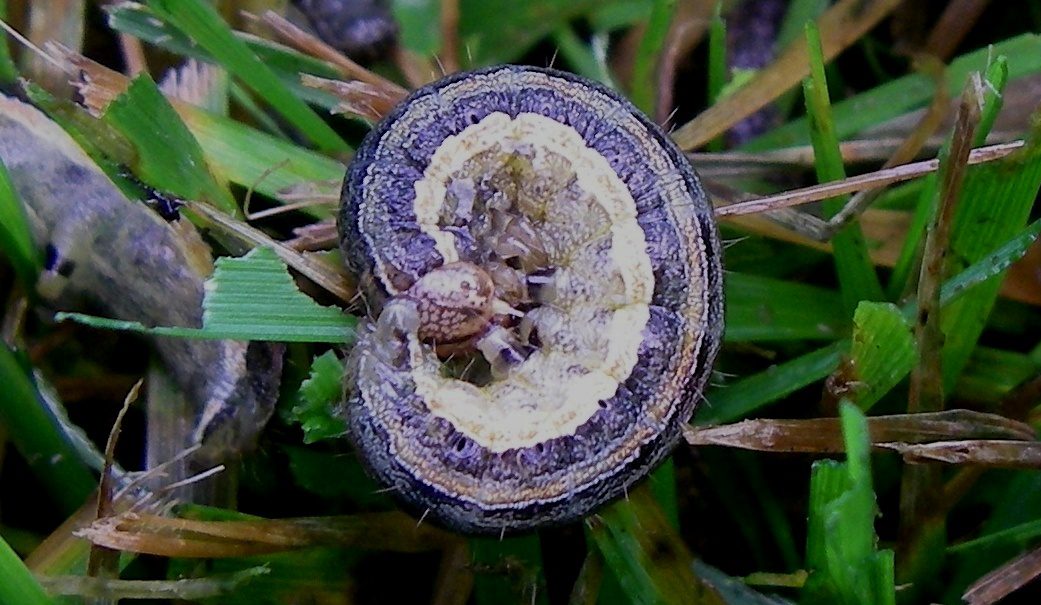
by Matt Lollar | Sep 23, 2015
Armyworms come in a wide range of colors and sizes. A few of the prominent species living in Florida are beet, southern, and fall armyworms. And the term “living” is not an exaggeration, because Florida is one of the lucky states where it is warm enough for armyworms to overwinter. They are the snowbirds that never leave!
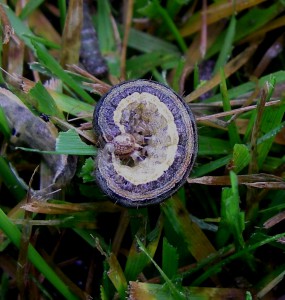
Armyworm damage on a lawn. Credit: Purdue University
Armyworms are notorious for unanticipated invasions. They feed on most turfgrass species and most vegetable crops, but they prefer grassy vegetable crops such as corn. Armyworms feed in large groups and their feeding has been described as “ground moving” in lawns. They feed during cooler times of the day (morning and evening) and they roll up and rest under the vegetative canopy (in the thatch layer in turf and in the base of leaves in vegetables) during the heat of the day.
Armyworms are difficult to control because of their spontaneity. However, in the lawn they hide in the thatch during the heat of the day. Over watering and fertilization can increase the amount of thatch. It is important to follow UF/IFAS guidelines for home lawn management. A good weed control program can also help to deter armyworms, because weeds serve as an alternate food source.
Numerous chemical control options are available, but softer chemicals such as horticultural oils and insecticides containing the bacteria Bacillus thuringiensis are recommended as a first line of defense. Insecticides should be applied in the morning or evening during feeding time. For additional control strategies and basic information please visit the UF/IFAS Armyworm Publication Page.
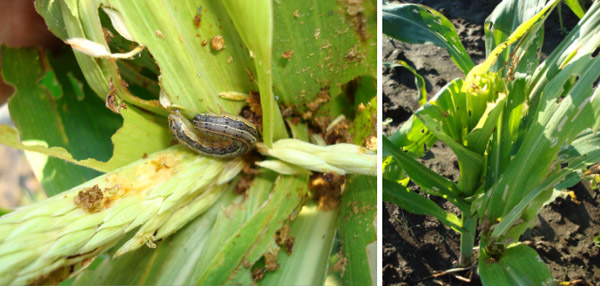
Armyworm feeding on a young corn plant. Credit: University of Illinois
by Sheila Dunning | Sep 16, 2015
“We have replaced this grass several times over the past few years; and it’s dying again.” I have heard this complaint too many times this summer. Last summer’s heavy rain, the stress of January’s icy weather, and this year’s extended summer have contributed to widespread outbreaks of Take-All Root Rot, a soil-inhabiting fungus Gaeumannomyces graminis var. graminis.
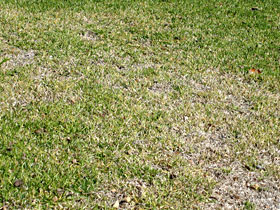
Symptoms of Take-All-Root-Rot. Photo credit: Sheila Dunning, UF/IFAS.
This disease causes yellow grass patches ranging in diameter from a few inches to more than 15 feet. The symptoms first appear in the spring, but the disease can persist all summer and survive the winter. Over time, the entire area dies as the root system rots away. The pathogen is naturally present on warm-season turfgrass roots. High rainfall and stressed turfgrass trigger the disease.
Since the roots are affected, they are not able to efficiently obtain water or nutrients from the soil, nor are they able to store the products of photosynthesis, which result in the loss of color in the leaves. By the time the leaf symptoms appear, the pathogen has been active on the roots for several weeks, probably longer; the disease has been there potentially for years. If the turfgrass is not stressed, leaf symptoms may never be observed.
This disease is very difficult to control once the aboveground symptoms are observed. Measures that prevent or alleviate stress are the best methods for controlling the disease. Any stress (environmental or manmade) placed on the turf weakens it, making it more susceptible to disease. Remember, that every maintenance practice, fertilizer application, and chemical (especially herbicide), application has an impact on turfgrass health. Cultural practices that impact the level of stress experienced by a lawn include:
- proper turfgrass species selection
- mowing at the correct height
- irrigation timing, frequency and volume
- fertilizer: nitrogen and potassium sources and application quantities
- thatch accumulation, and
- soil compaction
The selection of turfgrass species should be based on existing soil pH, sunlight exposure, use of the area and planned maintenance level.
Mower blades must be sharp to avoid tearing of the leaves. Additionally, turfgrasses that are cut below their optimum height become stressed and more susceptible to diseases, especially root rots. When any disease occurs, raise the cutting height. Scalping the grass damages the growing point. Raising the cutting height increases the green plant tissue available for photosynthesis, resulting in more energy for turfgrass growth and subsequent recovery from disease.
If an area of the lawn has an active fungus, washing or blowing off the mower following use will reduce the spread of the disease to unaffected areas.
The amount of water and the timing of its application can prevent or contribute to disease development. Most fungal pathogens that cause leaf diseases require free water (rainfall, irrigation, dew) on the leaf to initiate the infection process. Irrigating every day for a few minutes is not beneficial for the turfgrass because it does not provide enough water to the root zone, but it is beneficial for turfgrass pathogens. It is always best to irrigate when dew is already present, usually between 2 and 8 a.m., and then only apply enough water to wet the root zone of the turfgrass.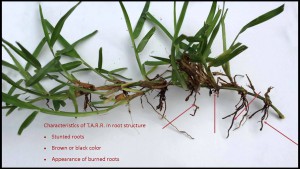
Excessively high nitrogen fertility contributes to turfgrass diseases. The minimum amount required for the grass species should be applied. Potassium (K) is an important component in the prevention of diseases, because it prevents plant stress. Application of equal amounts of nitrogen and potassium is recommended for turfgrass health. When turfgrass roots are damaged from disease, it is beneficial to apply nutrients in a liquid solution. However, nitrate-nitrogen increases the severity of diseases, so their use should be avoided when possible. Ammonium-containing fertilizers are the preferred nitrogen sources.
Heavy liming has also been linked to increases in Take-All Root Rot. Since most turfgrasses can tolerate a range of pH, maintaining soil at 5.5 to 6.0 can suppress the development of the pathogen. When the disease is active, frequent foliar applications of small amounts of nutrients is necessary to keep the turfgrass from declining.
Additional maintenance practices that need to be addressed are thatch removal and reduction of soil compaction. Excessive thatch often causes the mower to sink which can result in scalping and reducing the amount of leaf tissue capable of photosynthesizing. Thatch and compacted soil prevent proper drainage, resulting in areas remaining excessively wet, depriving root systems of oxygen. Since recovery of Take-All-Root-Rot damaged turfgrass is often poor, complete renovation of the lawn may be necessary. Removal of all diseased tissue is advised.
As a native soil-inhabiting pathogen, Take-All-Root-Rot cannot be eliminated. However, suppression of the organism through physical removal followed by proper cultivation of the new sod is critical to the establishment of a new lawn. Turfgrass management practices, not chemicals, offer the best control of the disease.
It is acceptable to use fungicides on a preventative basis while rooting in the sod. Azoxystrobin, fenarimol, myclobutanil, propiconazole, pyraclostrobin, thiophate methyl, and triadimefon are all fungicides that can be utilized to prevent disease development while having to excessively irrigate newly laid sod. Ideally, the turf area should be mowed and irrigated prior to a fungicide application. Unless the product needs to be watered in, do not irrigate for at least 24 hours after a chemical treatment. Do not mow for at least 24 hours, to avoid removal of the product attached to the leaf blades.
With all the stresses that our lawns have experienced, it is very important to continue monitoring the turf and be cautious about the cultural practices being used. Take-All Root Rot is likely to flourish. Do not encourage its development. A pathology test with the University of Florida Laboratory can confirm the presence of the disease causing organism. Before resodding again, have the dying sod tested.
For information and the submission form go to:
Sample Submission Guide
For more information on the disease go to:
Take-All-Root-Rot
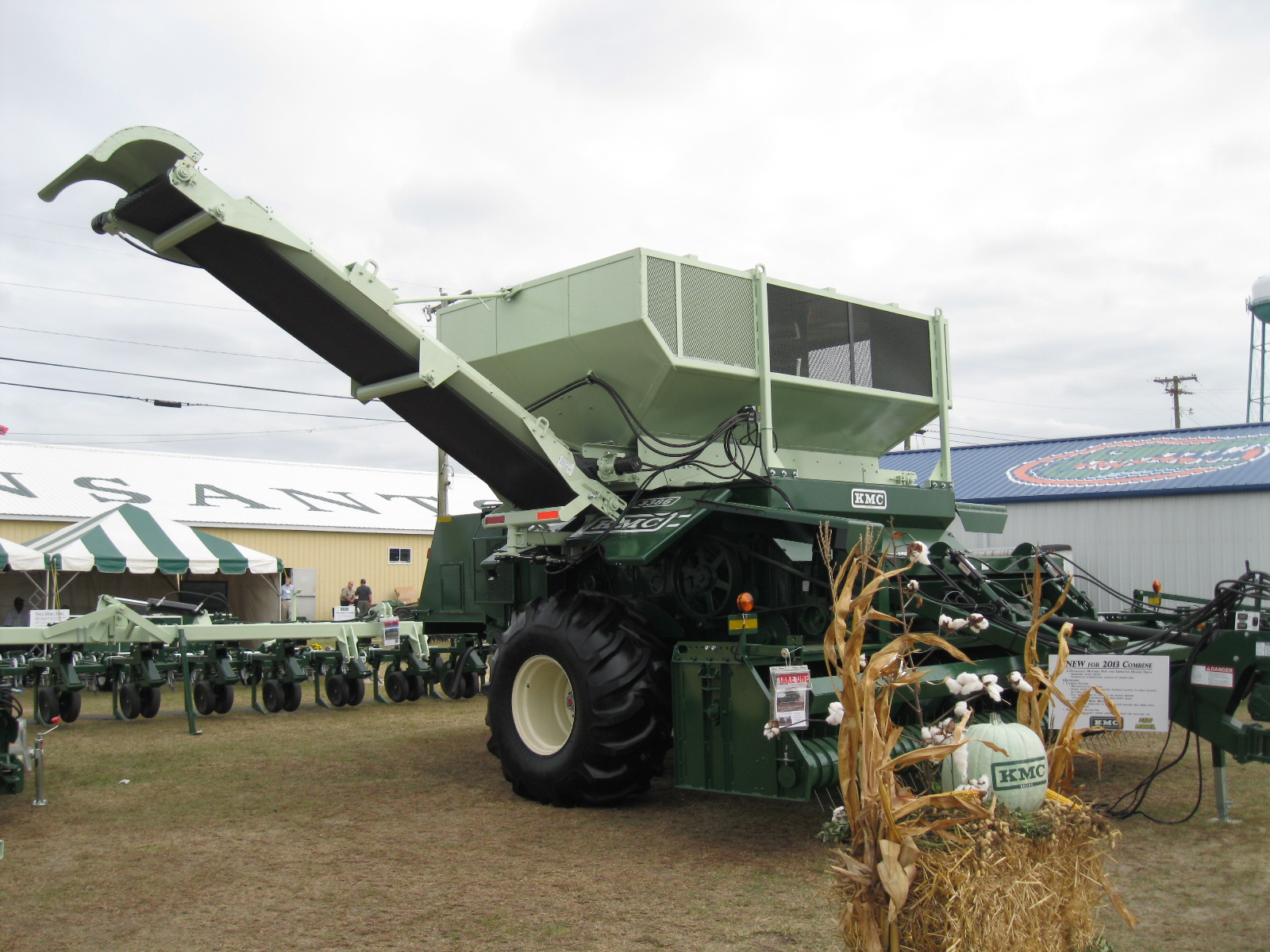
by Julie McConnell | Oct 8, 2014
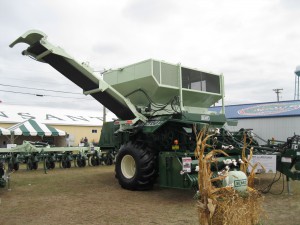 By Brad Buck, 352-294-3303, bradbuck@ufl.edu
By Brad Buck, 352-294-3303, bradbuck@ufl.edu
GAINESVILLE, Fla. – You can find out when to plant crops, how to can foods safely and how to use paper to pot plants from University of Florida experts at the 37th annual Sunbelt Ag Expo.
The Sunbelt Ag Expo, Oct .14-16 in Moultrie, Ga., is the largest agricultural expo in the southeast, and more than 100,000 people attend each year.
“The Sunbelt Expo gives people from all walks of life a chance to learn about everything Extension offers from our experts,” said Nick Place, dean of Extension for UF’s Institute of Food and Agricultural Sciences.
Known as North America’s Premier Farm Show and the largest such show in the U.S., the expo unites all segments of rural living. The setting features the latest agricultural research, a live farm harvest and insights into various agricultural businesses, according to its website.
UF/IFAS will have a permanent building, popular with visitors because of engaging displays and giveaways such as peanuts from the Florida Peanut Growers Association, Florida Orange Juice provided by Natalie’s Orchid Island Juice Company and many other “Gator Giveaways.”
This year, the Extension Service celebrates the centennial of the Smith-Lever Act of 1914, which created the national service, in which agents deliver unbiased research data to their constituents. Florida’s program remains as viable as ever, helping its many stakeholders. That includes guiding growers to maximize production through the most efficient use of their resources.
UF/IFAS’s three branches, Extension, research and the College of Agricultural and Life Sciences (CALS) will feature six interactive booths with the theme “Solutions for the Next 100 Years.”
Experts will interact with the public on several topics:
- “Canning parties” were some of the first Extension programs to help people better understand how to safely preserve foods. Expo visitors can learn more about this tradition as Family and Consumer Science Extension agents share from the past and present to provide the latest innovations for home food preservation.
- 4-H is one of UF/IFAS’ oldest recognized Extension programs. See how youth are leading and learning to meet the challenges of the next century. Visitors will learn about a 4-H recycling project and can take home a start to their family garden.
- Farming tools and methods are constantly improving. Visitors can see some of UF/IFAS’ favorites from the past and contrast them with flyin
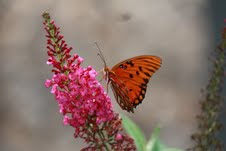 g drones and infrared scanners for today and the future. These new tools aid farmers in early identification of disease, pest and nutritional problems.
g drones and infrared scanners for today and the future. These new tools aid farmers in early identification of disease, pest and nutritional problems.
- Natural Resource and Sea Grant Extension agents are bringing Florida’s beaches and bays to Georgia. Touch tanks and displays with animals will highlight this exhibit focused on beach and boating safety and stewardship.
- Horticulture displays will give visitors insight into establishing a Florida Friendly yard by using appropriate plants and cultural methods. Butterfly gardening plants will be featured. Visitors will also learn how to distinguish beneficial insects from problem pests.
- Visit with CALS Ambassadors and learn about life as a UF agriculture student. Ambassadors will give information about major programs, admission, enrollment and hand out plenty of Gator goodies.
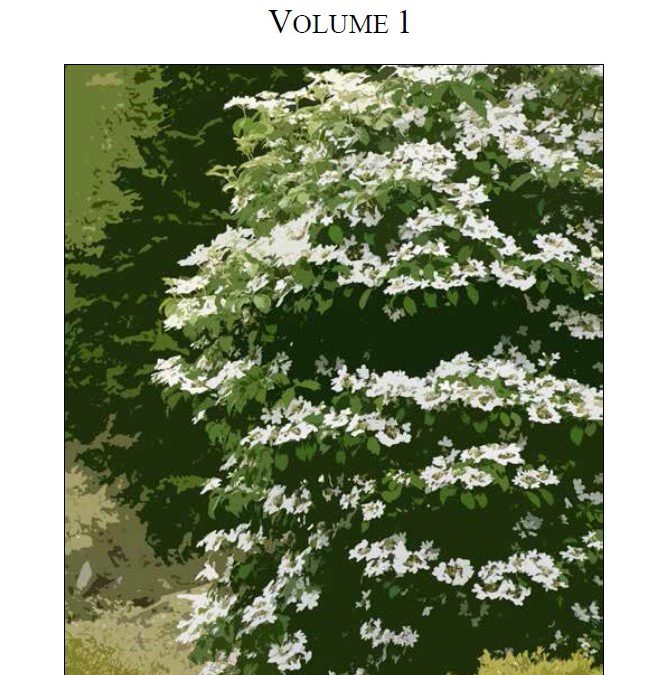
by Gary Knox | Aug 19, 2014
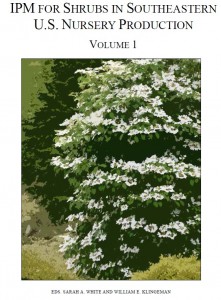 A new IPM guide is making it easier to grow five common southeastern shrubs. Growing five southeastern shrubs is now easier thanks to a free, new IPM resource from the Southern Nursery IPM Working Group.
A new IPM guide is making it easier to grow five common southeastern shrubs. Growing five southeastern shrubs is now easier thanks to a free, new IPM resource from the Southern Nursery IPM Working Group.
IPM for Shrubs in Southeastern U.S. Nursery Production is a compilation of Integrated Pest Management (IPM) information for five major shrubs in nursery crop production in the southeast. This 175 page book covers sustainable management for insects, mites, diseases, and weeds for these shrubs, as well as nursery production information. This IPM resource was developed for nursery growers although professional landscape managers and collectors of these plants also will find the information valuable.
Individual chapters cover abelia (Abelia spp.), camellia (Camellia spp.), shrub rose (Rosa spp.), blueberry (Vaccinium spp.) and viburnum (Viburnum spp.). Each chapter provides comprehensive information on the species, primary cultivars and their nursery production. Major pests, diseases, weeds and abiotic disorders are presented for each genus along with sustainable management methods and tables listing labeled pesticides and fungicides by mode of action and site. An additional chapter discusses weed management in shrub production. Future volumes covering additional shrubs are anticipated.
Edited by Clemson University’s Sarah A. White and University of Tennessee’s William E. Klingeman, this free guide was developed by the Southern Nursery IPM Working Group, including University of Florida NFREC’s Gary Knox and Mathews Paret. The award-winning, multi-disciplinary group is composed of experts from universities across the southeast. This group formed in 2008 to develop and deliver educational programming to the southern U.S. nursery industry and Extension personnel. The team recently won the 2014 Bright Idea Award from the Friends of Southern IPM and Southern IPM Center.
This resource joins the tree IPM book previously released by this group, IPM for Select Deciduous Trees in Southeastern US Nursery Production. The tree IPM book is similar to the new resource in that it contains IPM information for insects, mites, diseases, and weeds of nine major tree crops as well as production information. Individual chapters cover birch (Betula spp.), cherry (Prunus spp.), crapemyrtle (Lagerstroemia spp.), dogwood (Cornus spp.), chinese elm (Ulmus parvifolia), magnolia (Magnolia spp.), maple (Acer spp.), oak (Quercus spp.) and redbud (Cercis spp.).
Both books can be downloaded free through iTunes (http://www.apple.com/itunes/) or each chapter is available as a free pdf through the Southern Nursery IPM Working Group website, http://wiki.bugwood.org/SNIPM. A limited number of hardcopy books were printed and distributed to authors. Thanks to the Southern Region IPM Center for their generous support to make this resource possible!
by Gary Knox | Jul 21, 2014
Burgundy-leaved crapemyrtle is one of the most exciting breeding accomplishments in years. Unlike previous selections, many new crapemyrtle cultivars have leaves that retain dark burgundy coloration from spring budbreak through fall leaf drop. These plants add bold leaf color to a plant already known for its flower power.
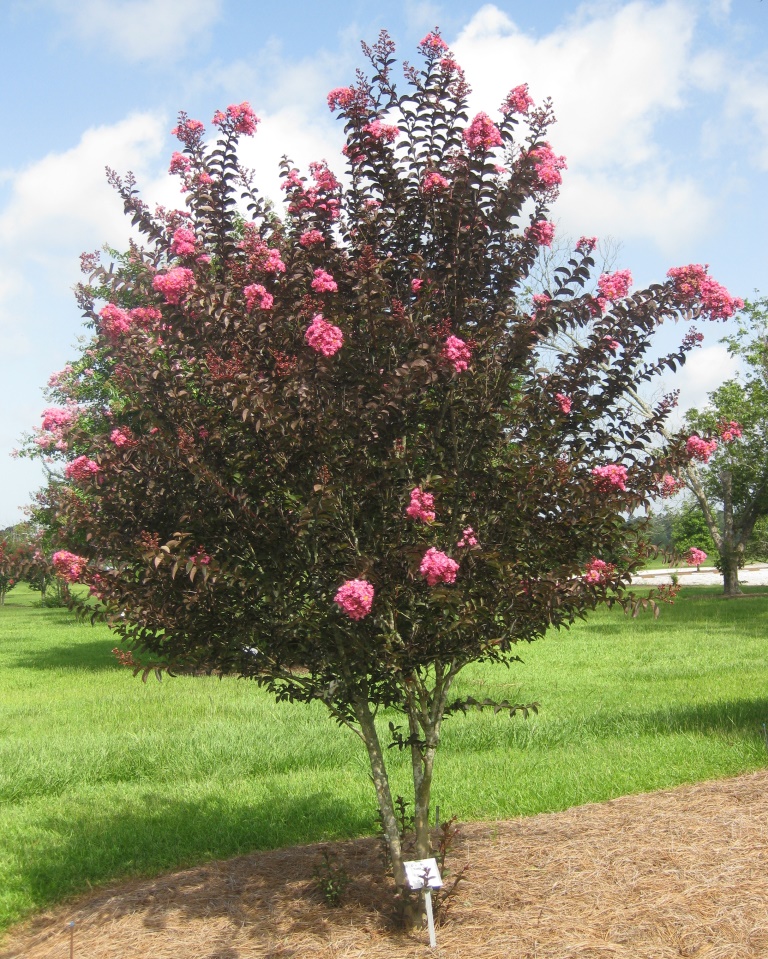
Delta Jazz™ was the first crapemyrtle with burgundy-bronze leaves all summer long. Photo by Gary Knox
As is typical of many new plant introductions, the new crapemyrtles are grouped and sold in series, most of which are patented and/or trademarked. Delta Jazz™ was the first crapemyrtle with burgundy-bronze leaves all summer long. This year Delta Jazz™, with pink flowers, is being joined by Delta Eclipse™ (purple flowers). Future years will see Delta Breeze™ (lavender flowers) and Delta Flame™ (red). All have burgundy to bronze leaves from spring through fall and are expected to be mid-size, maturing at heights of 8 to 12 feet.
Another new series with burgundy leaves confusingly is being sold under two names: the Ebony series and the Black Diamond™ series. ‘Ebony & Ivory’ features white flowers that contrast nicely with dark burgundy leaves on red stems. ‘Ebony Embers’ has red flowers on plants with dark burgundy leaves on purple stems. ‘Ebony Fire’ has flowers that are bright red and its leaves are medium burgundy. ‘Ebony Flame’ has dark red flowers and dark burgundy leaves. Finally, ‘Ebony Glow’ is named for its blush white flowers on dark red stems with dark burgundy leaves. These selections are also sold as Black Diamond™ Pure White, Black Diamond™ Red Hot, Black Diamond™ Crimson Red, Black Diamond™ Best Red and Black Diamond™ Blush, respectively. All are expected to grow 8 feet or more in height (regardless of the name!).
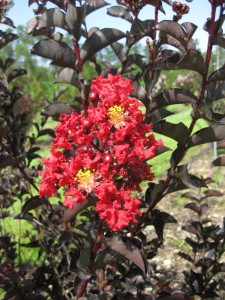
‘Ebony Fire’ is a new crapemyrtle with burgundy leaves and bright red flowers. Photo by Gary Knox
The First Editions® Magic™ series of crapemyrtles includes two new selections with burgundy leaves. Moonlight Magic™ has the darkest burgundy leaves I’ve seen so far. Flowers are white and the burgundy leaves are glossy and narrow on a plant expected to grow to a height of 8 to 10 feet. Maturing at 4 to 6 feet, Midnight Magic™ has leaves that are a dull burgundy while flowers are dark pink. Note that other cultivars in the First Editions® Magic™ series (‘Coral Magic’, ‘Plum Magic’, and ‘Purple Magic’) have green leaves.
These cultivars are too new to know how well they will perform in north Florida and the Gulf Coast. The best place to view these cultivars side by side is at the LSU AgCenter, Hammond Research Station, in Hammond, LA. There, Dr. Allen Owings has developed a beautiful garden where he is evaluating crapemyrtles and many other plants. For more information and to read Dr. Owing’s comments on new crapemyrtles, visit http://www.lsuagcenter.com/en/our_offices/research_stations/Hammond/.
All these new cultivars will have the brightest burgundy leaf color when plants are grown in full sun (at least 6 hours of direct sun each day). Any amount of shade will likely result in pale burgundy or burgundy-green leaves, as well as reduced flowering and growth. As with other crapemyrtles, these new cultivars are tolerant of drought, heat, rain, humidity and all but wet soils. When buying crapemyrtle, place the plant in a location where it can grow to its full height without the need to prune it regularly. After planting, sit back and enjoy these crapemyrtles’ bold burgundy foliage as well as the abundance of colorful flowers!
1Extension Specialist and Professor of Environmental Horticulture, University of Florida/IFAS, North Florida Research and Education Center, Quincy, Florida. gwknox@ufl.edu.
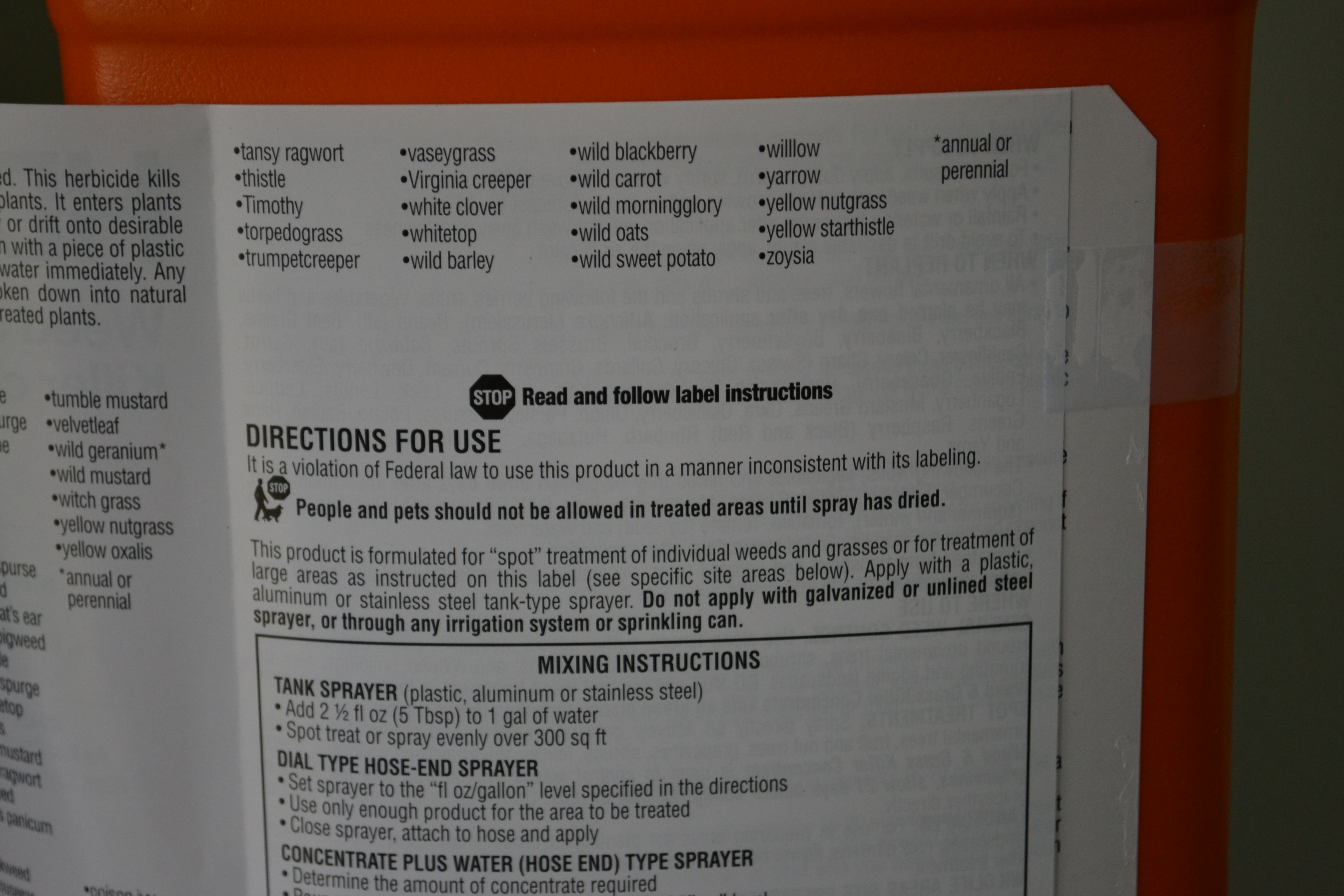
by Beth Bolles | Jul 21, 2014
You hear it all the time. Be sure to read the label before using any pesticide. Honestly though, is this a practice you really follow? It should be.
Sometimes we do not consider pesticides dangerous since we can buy them in most any retail store or garden center. Companies surely would not sell something to an average homeowner that is too toxic or dangerous.
Pesticides are chemicals that are used to kill insects, plants, and sometimes mammals. Even though many of the most dangerous chemicals are not available to homeowners, the products you find on stores shelves should still be used with care and attention. It is important to read the label. If not only to protect yourself, but to protect pets, children, wildlife, and water systems.
Each pesticide that you buy will come with a label. This label contains important information about the product. The following is a guide to the information found on a pesticide label and why it is required by law that you read it.
Active Ingredient: This is the chemical name of the pesticide and the part of the product that is active against the pest. Before buying your pesticide, look at the active ingredient to make sure that you are purchasing the right product for your specific job. You can not always judge a product by the trade name or brand name since several very different pesticides may have the same or very similar brand names.
Signal Words: The pesticide will either have Caution, Warning, or Danger in bold letters on the label. These words tell us the product’s level of toxicity. Caution – slightly toxic, Warning – moderately toxic; Danger – highly toxic. Most homeowner products will carry the Warning or Caution signal words.
Environmental Hazards: Many pesticides are toxic to birds, invertebrates, and mammals. Some products may not be used near water in order to protect wildlife. This section will guide you in ways to prevent damage to animals, groundwater, and soil.
Direction for Use. Each label will state how to apply the product so that it is most effective against the targeted pest. This will include rates, timing of applications, and pests controlled by the product. It is never beneficial to apply more than the label states.
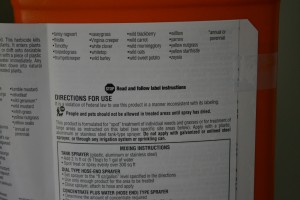
Pesticide labels are the law and must be followed.
Every label will contain additional information on precautions that need to be followed to safely use the pesticide and treatment if there is an accident. Since we are not able to predict when an accident will happen, make sure that you are always prepared by reading any pesticide label you will be using.








 g drones and infrared scanners for today and the future. These new tools aid farmers in early identification of disease, pest and nutritional problems.
g drones and infrared scanners for today and the future. These new tools aid farmers in early identification of disease, pest and nutritional problems.




